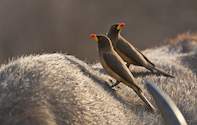
The chemical revolution that gave rise to the first pesticides was a deadly one for oxpeckers, with casualties amongst the birds arising from eating ticks filled with poisons and also from starvation as the pesticides reduced tick loads on cattle and other hosts. This led to the local extinction of the birds in many areas. More recently, pesticides have been developed that are not as harmful to oxpeckers and game farming is on the increase in South Africa.
This has paved the way for oxpeckers to be reintroduced into areas where they had become locally extinct, and hundreds of redbilled oxpeckers have been caught in the Kruger National Park (KNP) for relocation to other parts of South Africa.
The first reintroduction of oxpeckers in southern Africa took place from the Caprivi strip to KwaZulu-Natal. Following the success of this, in 1988 the first oxpeckers were captured in Kruger and later relocated to the Ben Lavin nature reserve and surrounding farms in the former northern Transvaal.
Since then, oxpeckers caught in Kruger have been translocated all over the country, to such destinations as Marakele National Park, Addo Elephant National Park, Kangwane Nature Conservation, Lapalala Wilderness, Tembe Elephant Park and Shamwari Game Reserve.
According to Dr Ian Whyte, Kruger's leading expert in oxpecker capture, few birds have been captured in recent years, partly as a result of the park closing waterholes in line with its management policy. The technique most successfully employed in Kruger to catch the birds involved setting up mist nets in the oxpeckers' preferred flight path between a windmill and its associated watering point. Ian says that the technique worked best in very dry years, as the birds were less wary of the necessary disturbances at the windmill. "In wetter years, we had little success."
Oxpeckers were also caught at the Skukuza bomas, where the birds were continually attracted by the constant source of host animals. Once caught, the birds were ringed and kept in specially designed holding facility in Skukuza that was constructed and donated by the Honorary Rangers. At first, donkeys were placed in the boma to help the birds become acclimatised.
Artificial food for the birds was placed on the donkeys, which helped the birds to quickly discover it. Ian comments, "Oxpeckers appear to be very intelligent and new arrivals in the boma quickly learnt from those already acclimatised to the boma and the new food." The birds were fed very finely minced beef mixed with egg yolk, Pronutro and vitamin and mineral supplements.
They were also given ox blood collected from an abattoir, which was mixed with water and other additives that prevent it from clotting. The birds had to be kept in the boma at Skukuza for a quarantine period to prevent them spreading the foot and mouth virus, which they could harbour as a result of ingesting blood from buffalo, which are reservoir hosts for the disease.
Oxpecker relocations are also handled by the Endangered Wildlife Trust (EWT). The EWT's Poison Working Group coordinates Operation Oxpecker, which educates farmers about oxpeckerfriendly pesticides. The group will arrange for the relocation of oxpeckers into areas where it has been confirmed that there are in xcess of 40,000ha of land where only oxpecker-friendly pesticides in use.
The first set of oxpeckers relocated by Operation Oxpecker were captured in Kruger and relocated to the eastern Cape. Operation Oxpecker provides support and advice to both cattle and game farmers about the use of pesticides, and has recently started a dung beetle-friendly initiative. For more information about Operation Oxpecker contact Arnaud le Roux on 082 325 6578.
By Melissa Wray

